Manual:Installing: Difference between revisions
No edit summary |
(Changes to the installation bit.) |
||
| Line 15: | Line 15: | ||
<!--T:1--> |
<!--T:1--> |
||
FreeCAD |
FreeCAD is licensed under the [https://en.wikipedia.org/wiki/GNU_Lesser_General_Public_License LGPL] license, which allows you to download, install, redistribute, and use it for any purpose, commercial or non-commercial, without any restrictions. You retain full ownership of the files you create. |
||
<!--T:2--> |
<!--T:2--> |
||
FreeCAD |
FreeCAD operates consistently across Windows, macOS, and Linux, although the installation process varies by platform. For Windows and Mac users, the FreeCAD community offers ready-to-use precompiled installers. On Linux, the source code is provided to distribution maintainers who package the software for their specific systems. Typically, Linux users can install FreeCAD directly through their system’s software manager. |
||
<!--T:3--> |
<!--T:3--> |
||
The official FreeCAD download page |
The official FreeCAD download page can be found at the [https://www.freecad.org/downloads.php FreeCAD download page]. Additional information about the installation process can be found at the dedicated [https://wiki.freecad.org/Download download wiki]. |
||
<!--T:4--> |
<!--T:4--> |
||
| Line 27: | Line 27: | ||
<!--T:5--> |
<!--T:5--> |
||
The official releases of FreeCAD |
The official stable releases of FreeCAD are available on the referenced download page and within your distribution's software manager. However, FreeCAD's development pace is brisk, with new features and bug fixes incorporated almost daily. Due to the extended periods between stable releases, you may want to experiment with more current, bleeding-edge versions of FreeCAD. These development versions, or pre-releases, can be found at the same download page. For users on Ubuntu or Fedora, the FreeCAD community also provides [https://launchpad.net/~freecad-maintainers/+archive/ubuntu/freecad-daily PPA] (Personal Package Archives) and [https://copr.fedorainfracloud.org/groups/g/freecad/coprs/ copr] 'daily builds', which are regularly updated with the latest developments. |
||
<!--T:6--> |
<!--T:6--> |
||
If you |
If you plan to install FreeCAD on a virtual machine, be aware that its performance might be significantly impaired, and perhaps unusable, due to limited OpenGL support in many virtual machines. |
||
=== Installing on Windows === <!--T:7--> |
=== Installing on Windows === <!--T:7--> |
||
<!--T:8--> |
<!--T:8--> |
||
# Download an installer (.exe |
# Download an installer (.exe) from the download page. The FreeCAD installers should work on any windows version starting from Windows 7. |
||
| ⚫ | |||
# Double-click the downloaded installer. |
|||
| ⚫ | |||
# You can leave the default path here, or change if you wish: [[Image:Freecad-windows-install-02.jpg|none]] |
# You can leave the default path here, or change if you wish: [[Image:Freecad-windows-install-02.jpg|none]] |
||
# No need to set the PYTHONPATH variable, unless you plan to do some advanced python programming, in which case you probably already know what this is for: [[Image:Freecad-windows-install-03.jpg|none]] |
# No need to set the PYTHONPATH variable, unless you plan to do some advanced python programming, in which case you probably already know what this is for: [[Image:Freecad-windows-install-03.jpg|none]] |
||
# During the installation, a couple of additional components, which are bundled inside the installer, will be installed too: [[Image:Freecad-windows-install-04.jpg|none]] |
# During the installation, a couple of additional components, which are bundled inside the installer, will be installed too: [[Image:Freecad-windows-install-04.jpg|none]] |
||
# |
# That’s it. The installation is now complete and you can start exploring the capabilities of FreeCAD. [[Image:Freecad-windows-install-05.jpg|none]] |
||
<!--T:9--> |
<!--T:9--> |
||
| Line 47: | Line 46: | ||
<!--T:10--> |
<!--T:10--> |
||
Packaging FreeCAD and |
Packaging FreeCAD and developing an installer involves a considerable investment of time and effort. As a result, development versions (also referred to as pre-release versions) are typically delivered in the form of .zip or .7z archives located at the [https://www.freecad.org/downloads.php FreeCAD download page]. There's no need for a formal installation process with these files; simply extract the contents and start FreeCAD by double-clicking the FreeCAD.exe file located inside. This approach also enables you to maintain both the stable and the "unstable" versions on the same computer. It’s like having both a dependable daily car and an experimental jet pack in your garage! |
||
=== Installing on Linux === <!--T:11--> |
=== Installing on Linux === <!--T:11--> |
||
<!--T:12--> |
<!--T:12--> |
||
For users of modern Linux distributions such as Ubuntu, Fedora, openSUSE, Debian, Mint, and Elementary, installing FreeCAD is as simple as a single click. You can seamlessly install it through the software management tool provided by your distribution, though the appearance of these tools may differ from any illustrative images, since each distribution employs its own distinct application. |
|||
<!--T:13--> |
<!--T:13--> |
||
| Line 62: | Line 61: | ||
<!--T:15--> |
<!--T:15--> |
||
One of the |
One of the great pleasures of using Linux is the vast array of options available for customizing your software experience, so don't hold back. For users of Ubuntu and its derivatives, FreeCAD can be installed from a [https://launchpad.net/~freecad-maintainers PPA] maintained by the FreeCAD community, which includes both stable and development versions. On Fedora, you can access the latest development versions of FreeCAD via [https://copr.fedorainfracloud.org/groups/g/freecad/coprs/ copr]. Additionally, since FreeCAD is open source, you also have the freedom to [[Compiling|compile FreeCAD yourself]]. |
||
=== Installing on Mac OS === <!--T:16--> |
=== Installing on Mac OS === <!--T:16--> |
||
| Line 70: | Line 69: | ||
<!--T:18--> |
<!--T:18--> |
||
# Download a zipped package corresponding to your version |
# Download a zipped package corresponding to your version. |
||
# Open the Downloads folder, and expand the downloaded zip file: [[Image:Freecad-mac-01.jpg|none]] |
# Open the Downloads folder, and expand the downloaded zip file: [[Image:Freecad-mac-01.jpg|none]] |
||
# Drag the FreeCAD application from inside the zip to the Applications folder: [[Image:Freecad-mac-02.jpg|none]] |
# Drag the FreeCAD application from inside the zip to the Applications folder: [[Image:Freecad-mac-02.jpg|none]] |
||
| Line 79: | Line 78: | ||
<!--T:20--> |
<!--T:20--> |
||
Ideally, you'll never want to part ways with FreeCAD, but should you ever need to uninstall it, rest assured the process is simple. On Windows, use the familiar "remove software" option from the control panel. For Linux users, uninstall it using the same software manager you employed to install it. Mac users have it easiest—just drag FreeCAD from the Applications folder to the trash. |
|||
=== Setting basic preferences === <!--T:21--> |
=== Setting basic preferences === <!--T:21--> |
||
Revision as of 20:53, 25 May 2024
- Introduction
- Discovering FreeCAD
- Working with FreeCAD
- Python scripting
- The community
FreeCAD is licensed under the LGPL license, which allows you to download, install, redistribute, and use it for any purpose, commercial or non-commercial, without any restrictions. You retain full ownership of the files you create.
FreeCAD operates consistently across Windows, macOS, and Linux, although the installation process varies by platform. For Windows and Mac users, the FreeCAD community offers ready-to-use precompiled installers. On Linux, the source code is provided to distribution maintainers who package the software for their specific systems. Typically, Linux users can install FreeCAD directly through their system’s software manager.
The official FreeCAD download page can be found at the FreeCAD download page. Additional information about the installation process can be found at the dedicated download wiki.
FreeCAD versions
The official stable releases of FreeCAD are available on the referenced download page and within your distribution's software manager. However, FreeCAD's development pace is brisk, with new features and bug fixes incorporated almost daily. Due to the extended periods between stable releases, you may want to experiment with more current, bleeding-edge versions of FreeCAD. These development versions, or pre-releases, can be found at the same download page. For users on Ubuntu or Fedora, the FreeCAD community also provides PPA (Personal Package Archives) and copr 'daily builds', which are regularly updated with the latest developments.
If you plan to install FreeCAD on a virtual machine, be aware that its performance might be significantly impaired, and perhaps unusable, due to limited OpenGL support in many virtual machines.
Installing on Windows
- Download an installer (.exe) from the download page. The FreeCAD installers should work on any windows version starting from Windows 7.
- Accept the terms of the LGPL license; this will be one of the few cases where you can really, safely click the "accept" button without reading the text. No hidden clauses:
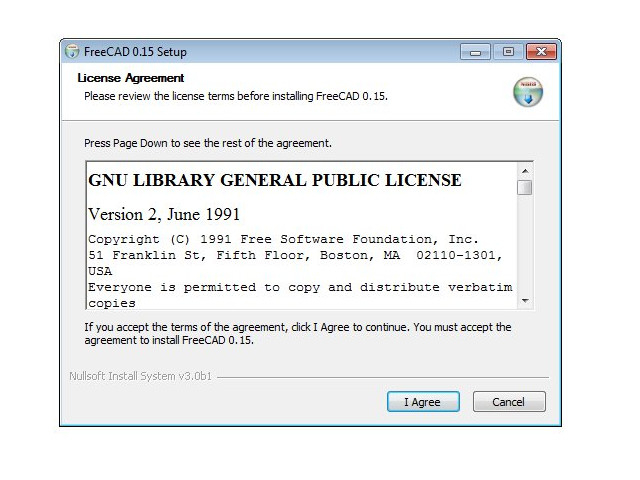
- You can leave the default path here, or change if you wish:
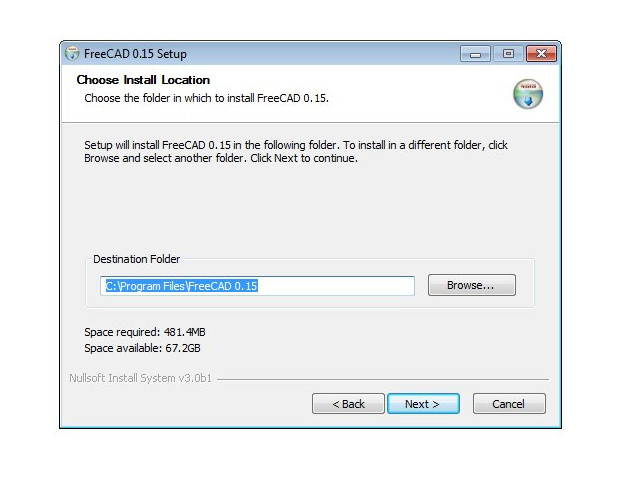
- No need to set the PYTHONPATH variable, unless you plan to do some advanced python programming, in which case you probably already know what this is for:
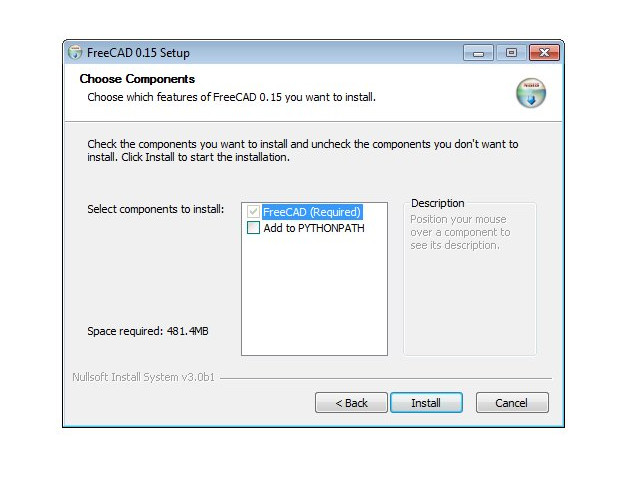
- During the installation, a couple of additional components, which are bundled inside the installer, will be installed too:
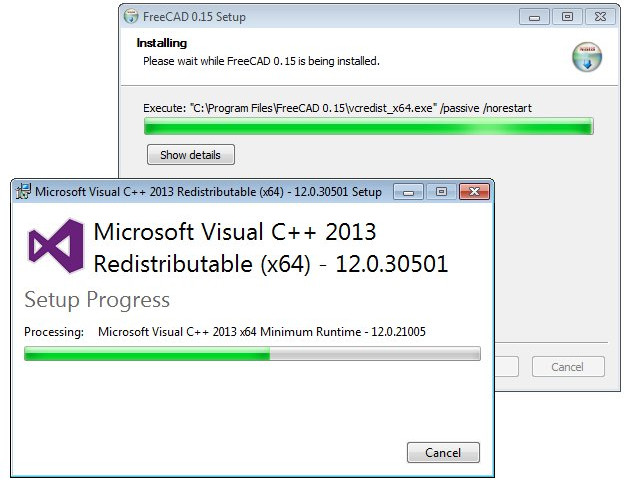
- That’s it. The installation is now complete and you can start exploring the capabilities of FreeCAD.
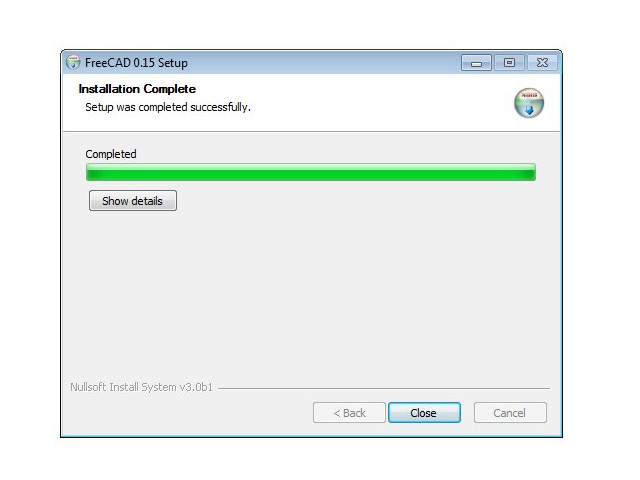
Installing a development version
Packaging FreeCAD and developing an installer involves a considerable investment of time and effort. As a result, development versions (also referred to as pre-release versions) are typically delivered in the form of .zip or .7z archives located at the FreeCAD download page. There's no need for a formal installation process with these files; simply extract the contents and start FreeCAD by double-clicking the FreeCAD.exe file located inside. This approach also enables you to maintain both the stable and the "unstable" versions on the same computer. It’s like having both a dependable daily car and an experimental jet pack in your garage!
Installing on Linux
For users of modern Linux distributions such as Ubuntu, Fedora, openSUSE, Debian, Mint, and Elementary, installing FreeCAD is as simple as a single click. You can seamlessly install it through the software management tool provided by your distribution, though the appearance of these tools may differ from any illustrative images, since each distribution employs its own distinct application.
- Open the software manager and search for "freecad":
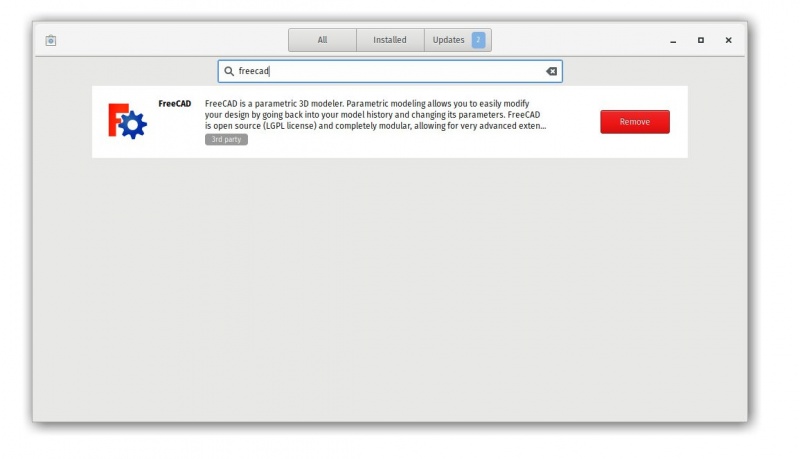
- Click the "install" button and that's it, FreeCAD gets installed. Don't forget to rate it afterwards!
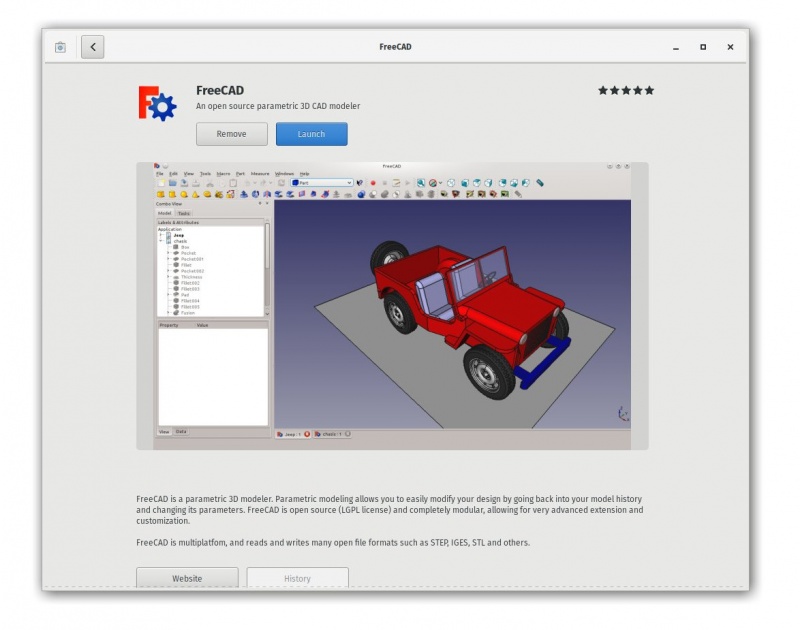
Alternative ways
One of the great pleasures of using Linux is the vast array of options available for customizing your software experience, so don't hold back. For users of Ubuntu and its derivatives, FreeCAD can be installed from a PPA maintained by the FreeCAD community, which includes both stable and development versions. On Fedora, you can access the latest development versions of FreeCAD via copr. Additionally, since FreeCAD is open source, you also have the freedom to compile FreeCAD yourself.
Installing on Mac OS
Installing FreeCAD on Mac OSX is nowadays as easy as on other platforms. However, since there are fewer people in the community who own a Mac, the available packages sometimes lag a few versions behind the other platforms.
- Download a zipped package corresponding to your version.
- Open the Downloads folder, and expand the downloaded zip file:
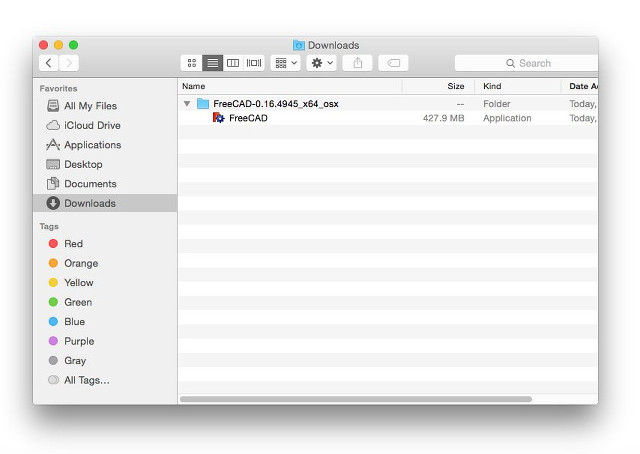
- Drag the FreeCAD application from inside the zip to the Applications folder:
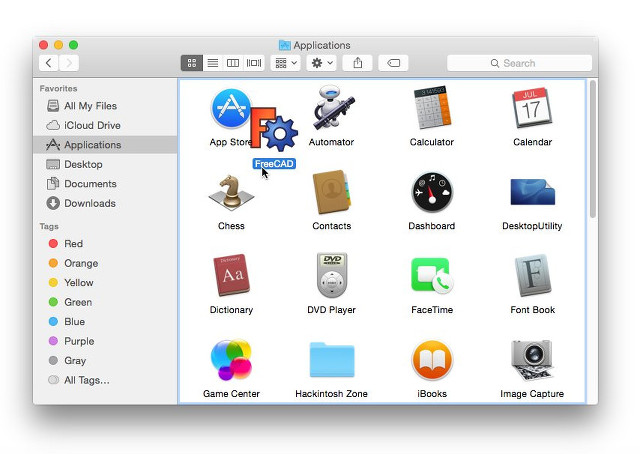
- That's it, FreeCAD is installed!
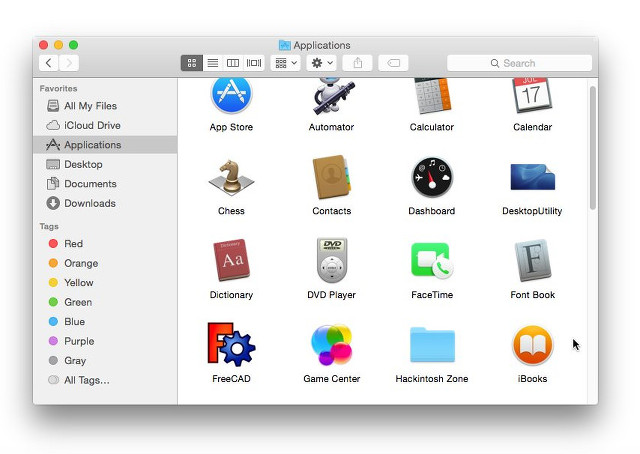
5. If the system prevents FreeCAD from launching due to restricted permissions for applications not coming from the App store, you will need to enable it in the system settings:

Uninstalling
Ideally, you'll never want to part ways with FreeCAD, but should you ever need to uninstall it, rest assured the process is simple. On Windows, use the familiar "remove software" option from the control panel. For Linux users, uninstall it using the same software manager you employed to install it. Mac users have it easiest—just drag FreeCAD from the Applications folder to the trash.
Setting basic preferences
Once FreeCAD is installed, you might want to open it and change some preferences. Preference settings in FreeCAD are located under menu Edit → Preferences. Listed below are some basic settings you may wish to change; you can browse through the preference pages to see if there is anything else you want to change.
- Language: (General category, General tab) FreeCAD will automatically pick the language of your operating system, but you might want to change that. FreeCAD is almost fully translated into five or six languages; others are currently only partially translated. You can easily help translating FreeCAD.
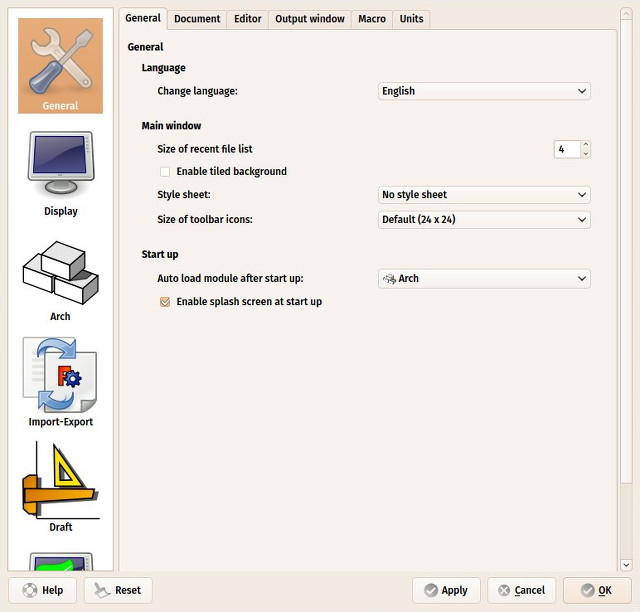
- Auto-load module: (General category, General tab) Normally, FreeCAD will start by showing you the start page. You can skip this and begin a FreeCAD session directly in the workbench of your choice, listed under Startup, Auto load module after startup. Workbenches will be explained in detail in the next chapter.
- Create new document at startup: (General category, Document tab) Combined with the Auto-load module option above, if checked this starts FreeCAD ready for work.
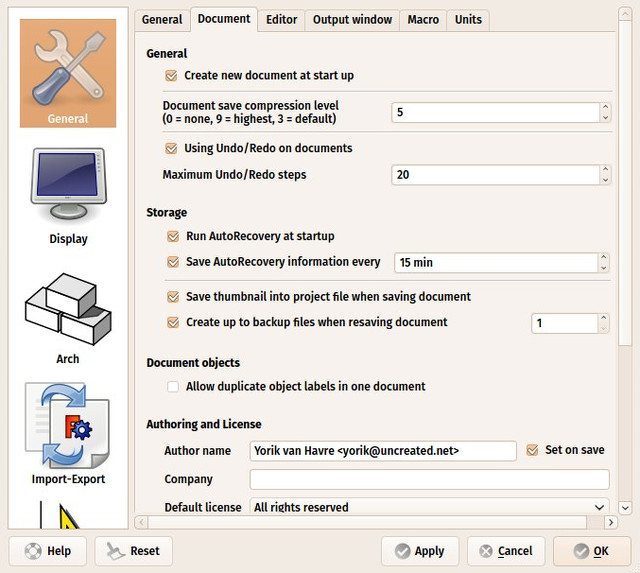
- Storage options: (General category, Document tab) As with any complex application, FreeCAD likely contains bugs causing it to crash occasionally. Here you can configure options to help you to recover your work in case of a crash.
- Authoring and license: (General category, Document tab) Here you set the values to be used for new files you create. Consider making your files shareable right from the start, by using a friendlier, copyleft license like Creative Commons.
- Redirect internal python messages: (General category, Output window tab) These two options are always good to check, as they will cause messages from the internal python interpreter to show up in the Report View when there's a problem running a python script.
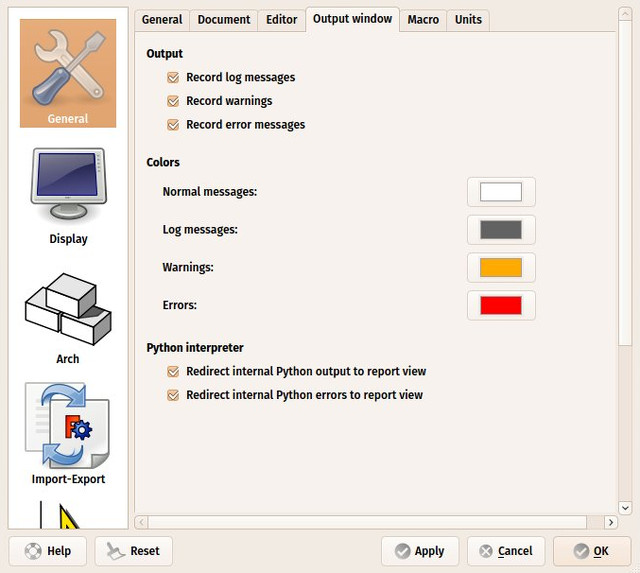
- Units: (General category, Units tab) Here you can set the default units system you wish to use.
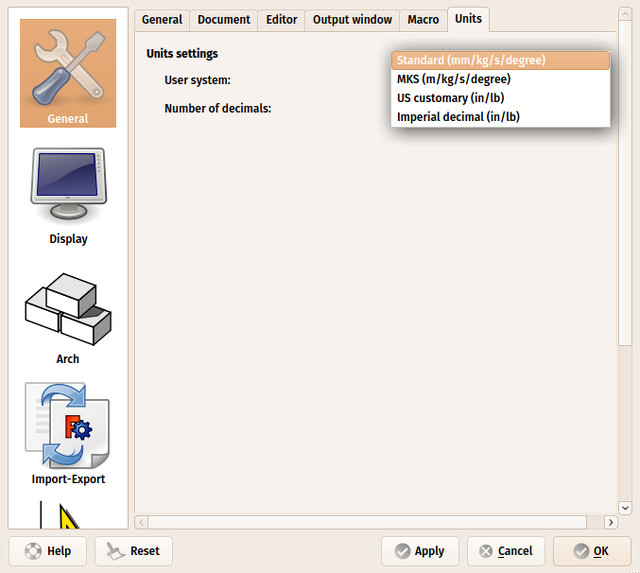
- Zoom at cursor: (Display category, 3D tab) If set, zoom operations will be focused at the mouse pointer. If unset, the center of the current view is the zoom focus.
- Invert zoom: (Display category, 3D tab) Inverts the direction of zooming relative to mouse movement.
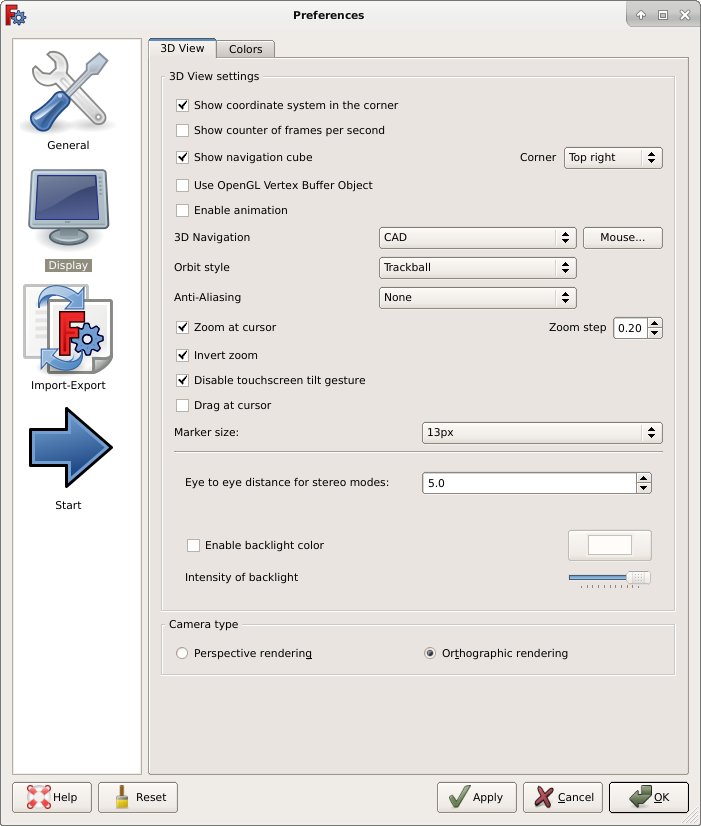
Installing additional content
As the FreeCAD project and its community grows quickly, and also because it is easy to extend, external contributions and side-projects made by community members and other enthusiasts begin to appear everywhere on the internet. Most of these external projects are workbenches or macros, and can be easily installed right from within FreeCAD via the Addon Manager located under menu Tools. The addons manager will allow you to install many interesting components, for example:
- A Parts library, which contains all kinds of useful models, or pieces of models, created by FreeCAD users that can be freely used in your projects. The library can be used and accessed right from inside your FreeCAD installation.
- Additional workbenches, that extend the functionality of FreeCAD for certain tasks, for example animate parts of your models, or areas, such as sheet metal folding or BIM. Further explanations of each workbench and what tools it contains is given on each addon page, that you can visit by clicking the corresponding link on the addon manager.
- A collection of macros, which are also available on the FreeCAD wiki along with documentation about how to use them.
If you are using the Ubuntu operating system, some of the addons above are also available as packages on the FreeCAD addons PPA
Read more
- More download options
- FreeCAD PPA for Ubuntu
- FreeCAD addons PPA for Ubuntu
- Compile FreeCAD yourself
- FreeCAD translations
- FreeCAD github page
- The FreeCAD addons manager


